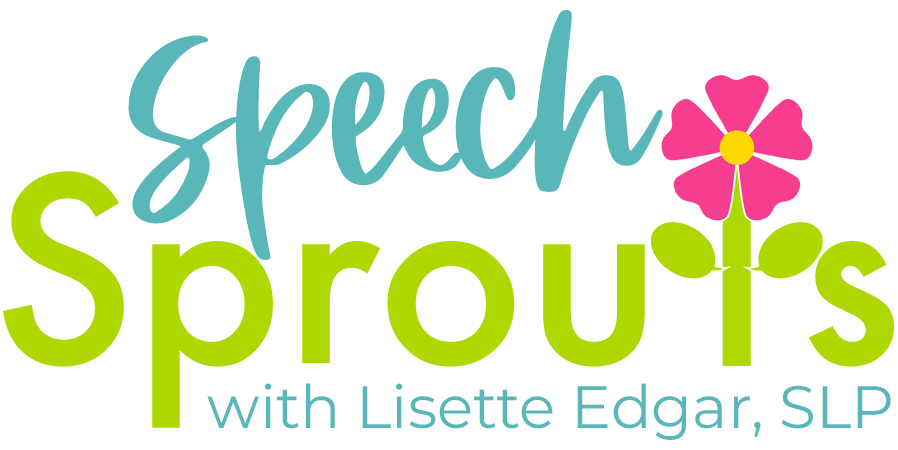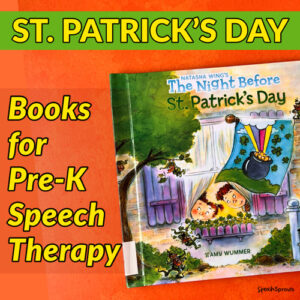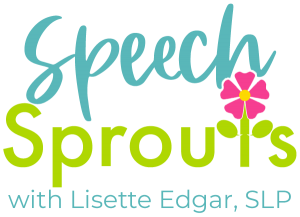
Childhood Apraxia of Speech: What SLPs Need to Know
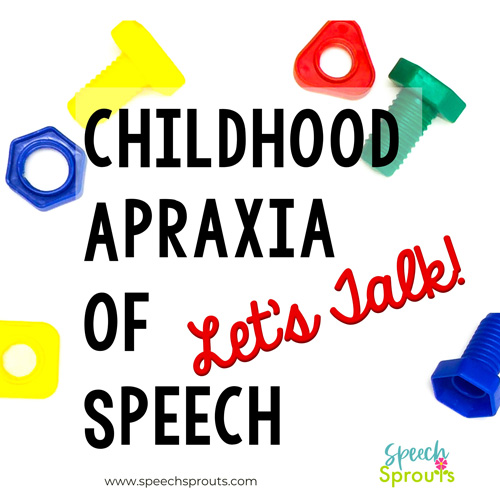
Childhood Apraxia of Speech: Let’s Talk About It
Are you a speech-language pathologist who has questions about the diagnosis and treatment of childhood apraxia of speech or CAS? You are not alone. So did I.
This post is the first in a series about childhood apraxia of speech.
I’ve been given an amazing opportunity to learn about the assessment and treatment of childhood apraxia of speech, and I’ve been tasked to spread the word about what I have learned to other speech-language pathologists. So I hope you will grab a hot cup of coffee and sit down with me, and let’s talk about it!
I love learning. The nerdy side of me gets excited about diving into a topic that interests me and I love unraveling as much information as I can absorb. Childhood apraxia of speech is one of those topics that I have been craving to know more about.
As a speech-language pathologist, I have seen how this speech disorder can affect a child’s communication, and I want to discover as much as I can about how to help.
Learning from Dr. Edythe Strand about CAS
This past weekend, I had the privilege to participate with 25 other clinicians in a marathon of learning on childhood apraxia of speech sponsored by the Once Upon a Time Foundation. The University of North Texas hosted Dr. Edythe Strand, Ph.D to teach us. I have attended one-day workshops given by Dr. Strand and couldn’t have been more thrilled to have this opportunity to learn more.
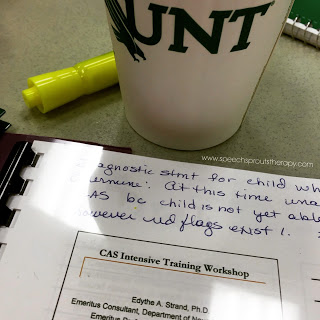
Dr. Strand is a dynamic teacher, researcher, and also a clinician herself. She is an Emeritus Consultant of the Department of Neurology at the Mayo Clinic in Rochester, Minnesota and Emeritus Professor at the Mayo College of Medicine. She is the former head of the Department of Speech Pathology at Mayo Clinic.
Dr. Strand has done groundbreaking research on CAS and developed an evidence-based treatment approach known as DTTC. She is considered a leading expert in the field. She is currently working on the development of a dynamic assessment for CAS. Dr. Strand is also funny, kind, encouraging, and passionate about her work.
Twenty hours of intensive focus on CAS meant we covered a LOT of ground.
This small group intensive training extended for three days, all day and evening sessions too. So I want to share in chunks. Let’s talk about one piece at a time.
I want you to know that I’m not an expert on childhood apraxia of speech in children. I am a clinician who, like many of you, serves children with CAS and seeks to learn as much as I can about how to provide the best treatment for this tricky disorder.
One purpose of this wonderful training was to share the knowledge we learned and help advance understanding about the diagnosis and treatment of CAS. So I am simply sharing my takeaways from what I have learned from Dr. Strand and a bit of my experience with CAS.
Before coming to this training, I had many questions, and I know many of you do too.
We talked about this in my earlier post, Childhood Apraxia of Speech: Your Questions. What are your questions? I hope this series will answer some of them for you.
So let’s start at the beginning.
Just what is childhood apraxia of speech?
In graduate school, SLPs are taught that CAS is a motor speech disorder.
The American Speech-Language-Hearing Association or ASHA has a position statement on Childhood Apraxia of Speech adopted in 2007 and recommends this definition:
Childhood apraxia of speech (CAS) is a neurological childhood (pediatric) speech sound disorder in which the precision and consistency of movements underlying speech are impaired in the absence of neuromuscular deficits (e.g., abnormal reflexes, abnormal tone).
CAS may occur as a result of known neurological impairment, in association with complex neurobehavioral disorders of known or unknown origin, or as an idiopathic neurogenic speech sound disorder.
The core impairment in planning and/or programming spatiotemporal parameters of movement sequences results in errors in speech sound production and prosody.
The American Speech-Language-Hearing Association
(ASHA, 2007b, Definitions of CAS section, para. 1)
Let’s look more closely at that.
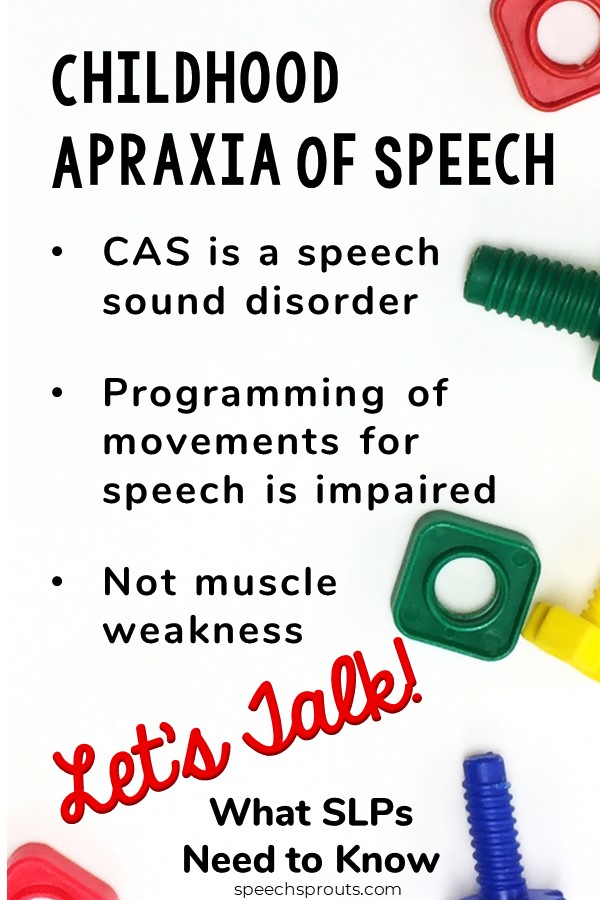
CAS is not a medical diagnosis.
CAS is a childhood neurologically based speech sound disorder. A speech sound disorder. Dr. Strand emphasized that CAS is not a medical diagnosis.
Some SLPs, particularly school-based SLPs, have reported that they have been told by their employers that they can not identify or diagnose CAS. The argument is that school employees cannot make medical diagnoses. If this is what you’ve been told, I encourage you to do your research and then discuss this with your employer. It’s truly important, because identification of the disorder is essential to framing thinking about treatment planning.
SLPs regularly identify speech and language disorders: phonological disorders, fluency disorders, and expressive and receptive language disorders. Similarly, it should be appropriate to identify CAS, if you have the specialized training and experience to do so. If you do not, please refer a child to an SLP that does have specialized training, as accurate diagnosis is important. I will talk more about the diagnosis of CAS in the next post.
CAS is a disorder of movement.
CAS is an impairment in the precision and consistency of the muscle movements necessary to produce speech. Programming of the movements is impaired, not the phonemes themselves.
This is important in framing our approaches to remediation. This is why therapy for CAS based on principles of Motor Learning Theory works and why a phonological approach, which emphasizes teaching the sounds of speech, is not the most effective approach to apraxia.
I should note here that there are several different approaches to treatment for childhood apraxia of speech, many of which show promise, and that one size does not fit all. But more about that later.
CAS is not the result of muscle weakness.
The movements underlying speech are impaired in the absence of neuromuscular deficits. CAS is not a result of weakness, abnormal tone, or reflexes. The core impairment is in planning the sequence of movements needed for speech production.
When we speak, our brain must program which muscles to move, when, in what order, how hard, and how far. A child with CAS has difficulty coordinating these movements, resulting in inaccurate speech sound production and prosody.
CAS can co-occur with other disorders, or present by itself.
This is one reason CAS can be so tricky to diagnose, even for the experts! A child with CAS can also have other diagnoses such as dysarthria, velopharyngeal insufficiency, ataxia, or autism. Often children with CAS will have linguistic deficits as well: difficulty with phonology, semantics, and syntax.
How many children have CAS?
Experts have identified many characteristics seen in CAS, but a lack of clear guidelines has made determining the actual incidence and prevalence of CAS difficult as discussed in ASHA’s Technical Report on Childhood Apraxia of Speech. Estimates at this time are that 1 or 2 in 100 children have CAS (Shriberg et al., 1997) and that 3.4%-4.3% of children identified with a speech disorder have CAS (Delaney & Kent, 2004).
The incidence of CAS is greater in boys than girls, and prevalence is reported to be higher in children with certain medical conditions. So if you have a caseload of 50 children, you might expect to have one or two children with CAS on average. Of course, the actual number on your specific caseload can vary.
Dr. Strand has a YouTube series you need to check out.
These videos were made to help explain CAS to parents, but they have terrific information and excellent video examples for SLPs too. I highly recommend you take a look and share it with parents.
The Whole Thing: Childhood Apraxia of Speech: Information for Parents
This video is 52 minutes long and contains all the segments. But you can also view her videos in shorter segments.
In this video, Dr. Strand explains what childhood apraxia of speech is, and talks about key terms. Definitions and Descriptions of Childhood Apraxia of Speech
So how do I assess CAS and exactly what do I look for?
In my next post in the series, I talk about what you need to know about diagnosing CAS. Read the second post in this series Is it CAS? Navigating Differential Diagnosis.
Share it:
- Read more about: Apraxia, Articulation
